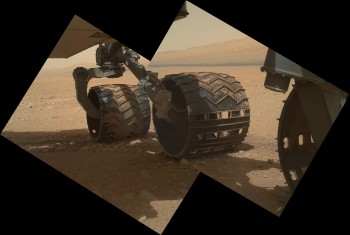Driving Curiosity
October 22, 2015
Planetary Sciences

In September 2014, two years after it first arrived on the Martian surface, NASA’s Curiosity rover completed its 5-mile trek to its primary destination: Mount Sharp, officially called Aeolis Mons. Among those behind the proverbial wheel of the rover was Mackenzie Day, a doctoral student at the Jackson School of Geosciences and a Keeper of the Plan for the Curiosity mission—a title that says she gets to help tell the rover what to do.
“It’s not a joystick in a box,” Day said about driving. “All commands are sent using code.”
Each day she attends a conference call between NASA personnel and international collaborators to discuss what Curiosity will do and what samples it will take; she’s especially partial to pit-stops for transverse aeolian ridges, a wind-sculpted sand formation found only on Mars and a major player in her dissertation comparing aeolian processes on Earth and Mars.
Day then takes the mission team’s commands and prepares them for transmission to the rover. Now that the rover has reached the base of Mount Sharp, Day will be driving the rover farther up the Mount Rainier-sized mountain to document and sample the 3 billion years of Martian geology recorded in its sedimentary layers. She said seeing and sampling Mars through the rover is awe-inspiring. But she has hopes to experience the Martian vista in person one day. After earning her doctorate, Day plans to apply for the NASA astronaut program.
Back to the Newsletter